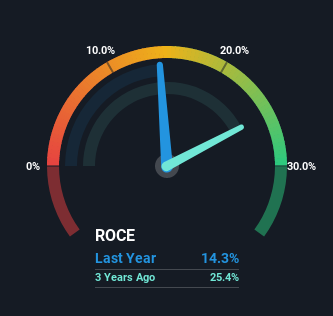Stock Analysis
The Returns On Capital At Dali Foods Group (HKG:3799) Don't Inspire Confidence

If we want to find a stock that could multiply over the long term, what are the underlying trends we should look for? In a perfect world, we'd like to see a company investing more capital into its business and ideally the returns earned from that capital are also increasing. Put simply, these types of businesses are compounding machines, meaning they are continually reinvesting their earnings at ever-higher rates of return. Having said that, from a first glance at Dali Foods Group (HKG:3799) we aren't jumping out of our chairs at how returns are trending, but let's have a deeper look.
What Is Return On Capital Employed (ROCE)?
If you haven't worked with ROCE before, it measures the 'return' (pre-tax profit) a company generates from capital employed in its business. The formula for this calculation on Dali Foods Group is:
Return on Capital Employed = Earnings Before Interest and Tax (EBIT) ÷ (Total Assets - Current Liabilities)
0.14 = CN¥2.7b ÷ (CN¥27b - CN¥7.9b) (Based on the trailing twelve months to December 2022).
Thus, Dali Foods Group has an ROCE of 14%. On its own, that's a standard return, however it's much better than the 9.7% generated by the Food industry.
See our latest analysis for Dali Foods Group

In the above chart we have measured Dali Foods Group's prior ROCE against its prior performance, but the future is arguably more important. If you're interested, you can view the analysts predictions in our free report on analyst forecasts for the company.
What Can We Tell From Dali Foods Group's ROCE Trend?
When we looked at the ROCE trend at Dali Foods Group, we didn't gain much confidence. Around five years ago the returns on capital were 26%, but since then they've fallen to 14%. Given the business is employing more capital while revenue has slipped, this is a bit concerning. If this were to continue, you might be looking at a company that is trying to reinvest for growth but is actually losing market share since sales haven't increased.
While on the subject, we noticed that the ratio of current liabilities to total assets has risen to 29%, which has impacted the ROCE. If current liabilities hadn't increased as much as they did, the ROCE could actually be even lower. Keep an eye on this ratio, because the business could encounter some new risks if this metric gets too high.
The Bottom Line
In summary, we're somewhat concerned by Dali Foods Group's diminishing returns on increasing amounts of capital. It should come as no surprise then that the stock has fallen 36% over the last five years, so it looks like investors are recognizing these changes. That being the case, unless the underlying trends revert to a more positive trajectory, we'd consider looking elsewhere.
Dali Foods Group does have some risks though, and we've spotted 1 warning sign for Dali Foods Group that you might be interested in.
If you want to search for solid companies with great earnings, check out this free list of companies with good balance sheets and impressive returns on equity.
Valuation is complex, but we're helping make it simple.
Find out whether Dali Foods Group is potentially over or undervalued by checking out our comprehensive analysis, which includes fair value estimates, risks and warnings, dividends, insider transactions and financial health.
View the Free AnalysisHave feedback on this article? Concerned about the content? Get in touch with us directly. Alternatively, email editorial-team (at) simplywallst.com.
This article by Simply Wall St is general in nature. We provide commentary based on historical data and analyst forecasts only using an unbiased methodology and our articles are not intended to be financial advice. It does not constitute a recommendation to buy or sell any stock, and does not take account of your objectives, or your financial situation. We aim to bring you long-term focused analysis driven by fundamental data. Note that our analysis may not factor in the latest price-sensitive company announcements or qualitative material. Simply Wall St has no position in any stocks mentioned.
About SEHK:3799
Dali Foods Group
Dali Foods Group Company Limited, an investment holding company, manufactures and sells food and beverages in Mainland China.
Excellent balance sheet and fair value.

